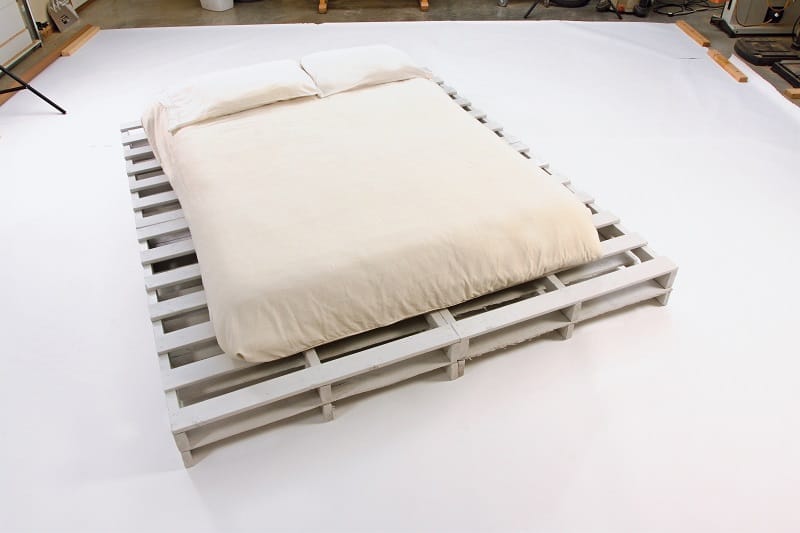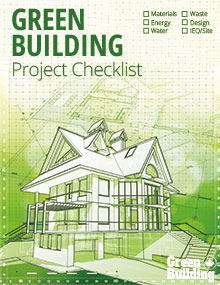The Hunt for Pallets
It’s not hard to find pallets for reclamation because they’re used to ship so many materials and products. The trick is to locate pallets that are in fairly decent shape and that aren’t spoken for. Although the easiest places to find a wealth of pallets are behind big-box stores and large retailers where they may be stacked haphazardly, many of these companies have agreements with recyclers or junk removal services to bulk collect used pallets. (Remember, pallets in good shape can be reused again and again.)
Unless the pallets have obviously been discarded as trash—on the curb during large trash pickup day or in a local dump—you’ll need to ask permission to take them. That said, many companies are more than willing to have you cart them off. That includes construction companies on large construction sites, where they often don’t have anywhere to store pallets to keep them out of the path of workers and vehicles, and they may not have arranged to have the pallets removed. You may also get lucky and find whole dumpsters full of unbroken or slightly damaged pallets.
Regardless of where you find them, you’ll want to make absolutely sure that the pallets you reclaim are safe for reuse. This involves determining if they have been used to transport any toxic or dangerous materials and avoiding those that have. Fortunately, most pallets are marked on the top, bottom or sides, and the markings often tell the story of where the pallet came from and what it carried.
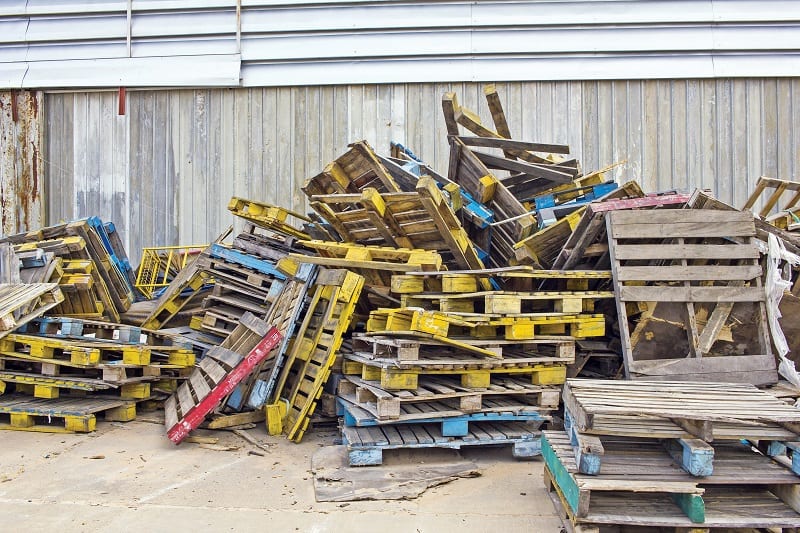
Platform Bed Project
A comfortable bed is one of life’s great luxuries. Although we think of the mattress as the key to comfort, mattresses are just one part of the equation. The best beds provide a solid foundation that doesn’t feel like it might collapse under you as you toss and turn during the night. The bed should also support the mattress in a way that will ensure the greatest longevity of the mattress, because mattresses are anything but cheap. Fortunately, you can save a nice little chunk of change with a pallet bed like the one in this project. You’d be hard pressed to find a bed more secure and simple to construct than this platform.
The design of this platform bed is unconventional and lends a modern, almost industrial look to a bedroom (although the bed itself can be entirely concealed with oversized blankets or comforters). It’s an exceedingly simple look that you can dress up in a number of ways, from painting the pallets to siding them with a custom-made fabric “skirt.”
No matter what you think of the look, though, there’s no disputing that the construction of this project is perfect for the amazingly popular proliferation of memory foam mattresses. Unlike box spring sets that require only side rails for support, memory foam mattresses call for a firm foundation with closely spaced slats. The gaps between slats allow for air circulation that will help combat mildew and dust mites, and a platform bed like this eliminates annoying squeaks and sounds common to rail frames and less sturdy slatted beds.
The design in this project is sized to accommodate a standard queen-size mattress, although it can support a king-size unit if you’re willing to give up some of the border space on the platform. A smaller double or twin mattress will look lost on the platform though.
One of the wonderful things about this bed is that it’s so easy to assemble. Because the bed sits flat on the floor it is relatively self-levelling, and there are no precise measurements to take in the fabrication process. You also won’t need any special skills or tools. You can make the process even easier by nailing, rather than screwing, the pallets together (just use more nails). As a bonus, it’s almost risk-free. If you find that the bed isn’t to your liking, it can easily be deconstructed and the pallets reused in another project.
Picking the Right Mattress
The beauty of a platform bed like this is that you don’t need a box spring, which potentially saves you a good bit of money. However, depending on the type of mattress you select, you can easily eat up that savings. Manufacturers are increasingly offering hybrids, such as mattresses that pair an innerspring core with a memory foam top, but the market is still dominated by sales of the individual types listed here.
Innerspring – This is the traditional mattress, usually paired with a box spring that’s mounted on a traditional metal rail frame. But the mattress will last just as long and perform just as well on the slatted surface of a pallet platform bed like the one in this project. Quality among innerspring mattresses varies wildly. A bare unit with minimal padding over the spring core will cost little more than $100 and can be expected to be comfortable for five years at most. A luxury “pillow top” mattress with thick padding and a heavy-duty frame may carry a 20-year warranty and a price tag close to $1,000. There are a wealth of options in between.
Foam – The most recent innovation in mattress technology, memory foam units continue to grow in popularity. The thickness and type of foam (most companies use proprietary formulas) determine comfort, longevity and price. At the high end of the spectrum, these mattresses can run thousands of dollars and offer a premium sleep experience. But even at the budget end, these miracles of modern technology offer sleep comfort most people find superior. Foam mattresses are ideal for a pallet platform bed because the technology actually requires the mattress be placed on a slatted surface with gaps, rather than a solid platform. The weight also ensures that the mattress moves around on the platform less than an innerspring or air mattress would.
Air – Air mattresses can be adjusted to suit your preferred firmness, and they’re the least expensive among the options listed here. However, they’re also the least comfortable and tend to make noises as you move during sleep. They’re the least desirable option because they’re prone to movement and the pallet platform bed in this project doesn’t include channels or fences to hold a mattress in place.
Futon – A time-tested type of simple mattress formed of layers of batting surrounded by a durable canvas body, futons are an acquired taste. The surface is softer than a floor, but harder than any other mattress type. Futons are relatively inexpensive and, because of their simple construction, can last decades. Used on a pallet platform bed, they raise the top level of the bed only a couple of inches, so if you choose a futon, be sure the bed as you’ve built it is at the height you prefer.
What You’ll Need
Time: 1.5 hours
Difficulty: Easy
Tools:
- Pry bar
- Palm sander
- Paintbrush (optional)
- Hammer
- Power drill and screw bits
Materials:
- 8 pallets
- 100-grit sandpaper
- Primer (optional)
- White gloss enamel paint
- (optional)
- 3” [76 mm] wood screws
- (14) 4” [102 mm] zinc mending plates and screws
- 4” [102 mm] wood screws
- Self-adhesive felt furniture pads
How You Make It
Prepare the pallets
Remove the bottom deck boards from eight standard pallets. Smooth the pallets all over with a palm sander, so that no rough spots or splinters remain.
Prime and paint
If you’re painting the bed, prime and paint the pallets all over. You can paint them any colour, but white is the most common and the least likely to go out of style. If you don’t like white, grey or very pale blue or green would work for most bedrooms.
Start with the head
Set four pallets in a grid, laying upside-down on the top deck boards, with the stringers running from what will be the foot of the bed to the head (notched edges up). Fasten the two pallets together, side by side at the head of the bed, with 3” wood screws. Drive screws every few inches, alternating sides.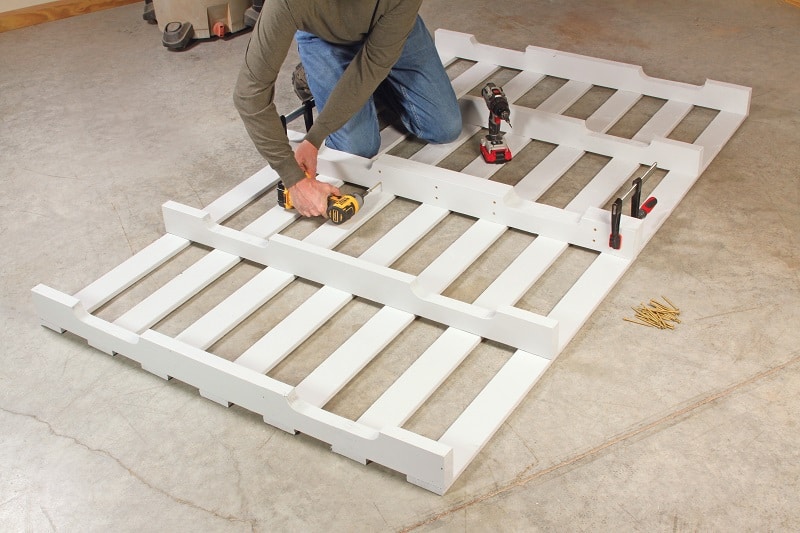
Connect the head and the foot
Repeat the process with the two pallets at the foot of the bed. Fasten the stringers of the foot pallets to the head pallet stringers with 4” zinc mending plates screwed to both sides of each stringer pair. Reinforce the connection by screwing mending plates at the centre point of the deck boards (on the underside) across the pallets.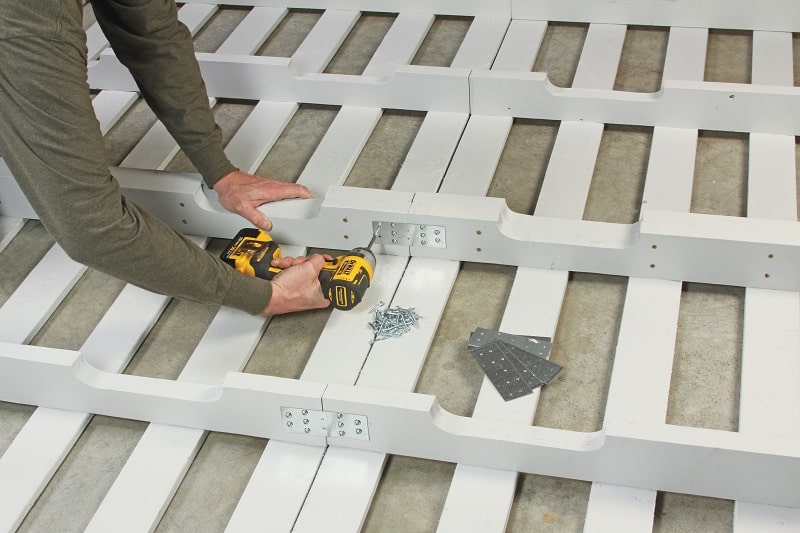
Build the base layer
Build the base layer on top of the first layer, notched edge up, with the remaining four pallets fastened in exactly the same way.
Fasten the layers together
Alternating sides, drive 4” wood screws down through the stringers of the top layer, into the stringers of the layer below. Attach self-adhesive felt furniture pads every 3” (or 7.6 centimetres) along the bottom of each top stringer.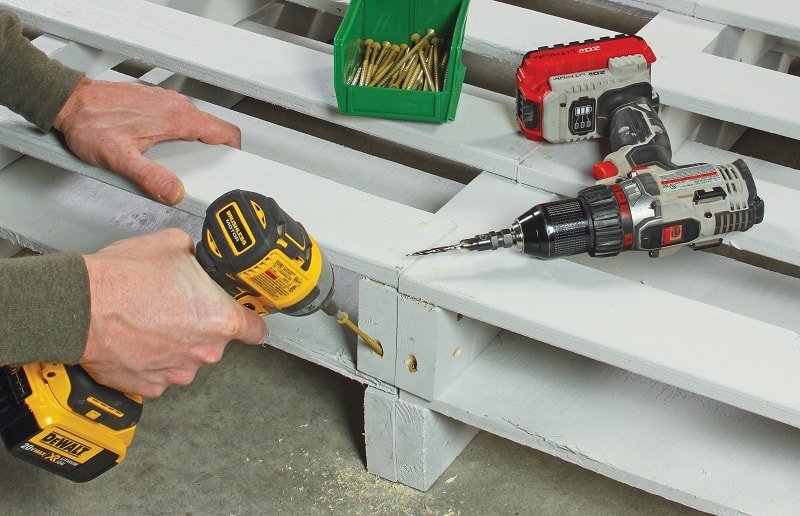
Set up the bed in its final location
Use a helper to flip the bed and position it in its final location. Check for any splinters or rough spots before sitting the mattress on top of the bed frame.
Sample Beds


For another upcycling project from the same author, check out How to Construct Durable End Grain Flooring in 4 Steps»
 Chris Peterson is a veteran home improvement and design author. Among the many books he has written are 5-Gallon Bucket Book, Building with Secondhand Stuff, Manskills, four books in the Ideas You Can Use series and many books in Cool Springs Press’s BLACK+DECKER Complete Guide series. He has also co-authored numerous home design books with noted media celebrities. He lives in Ashland, Oregon (U.S.).
Chris Peterson is a veteran home improvement and design author. Among the many books he has written are 5-Gallon Bucket Book, Building with Secondhand Stuff, Manskills, four books in the Ideas You Can Use series and many books in Cool Springs Press’s BLACK+DECKER Complete Guide series. He has also co-authored numerous home design books with noted media celebrities. He lives in Ashland, Oregon (U.S.).The Pallet Book: DIY Projects for the Home, Garden, and Homestead by Chris Peterson. Published by Voyageur Press, an imprint of The Quarto Group. Out now.
Have some leftover pallets and ready for another DIY project? Learn how to Convert 2 Recycled Pallets Into a Chair»
Image 1: Teona Swift

